
Hellraiser is a 1987 British supernatural horror film written and directed by Clive Barker in his directorial debut, Based on Barker's 1986 novella The Hellbound Heart, the film’s plot concerns a mystical puzzle box that summons the Cenobites, a group of extra-dimensional, sadomasochistic beings who cannot differentiate between pain and pleasure. It stars Andrew Robinson, Clare Higgins, Ashley Laurence, and Doug Bradley as the leader of the Cenobites, identified in the sequels as "Pinhead".

The Hellbound Heart is a horror novella by Clive Barker, first published in November 1986 by Dark Harvest in the third volume of its Night Visions anthology series. The story features a hedonist criminal acquiring a mystical puzzle box, the LeMarchand Configuration, which can be used to summon the Cenobites, demonic beings who do not distinguish between pain and pleasure. He escapes the Cenobites and, with help, resorts to murder to restore himself to full life. Later on, the puzzle box is found by another.

The Cenobites are fictional, extra-dimensional, and seemingly demonic beings who appear in the works of Clive Barker. Introduced in Barker's 1986 novella The Hellbound Heart, they also appear in its sequel novel The Scarlet Gospels, the Hellraiser films, and in Hellraiser comic books published (intermittently) between 1987 and 2017. In the 1987 novel Weaveworld, they are mentioned in passing as "The Surgeons". The Cenobites appear in prose stories authorized but not written by Clive Barker, such as the anthology Hellbound Hearts edited by Paul Kane and Marie O'Regan, the novella Hellraiser: The Toll, and the novel Sherlock Holmes and the Servants of Hell written by Paul Kane.
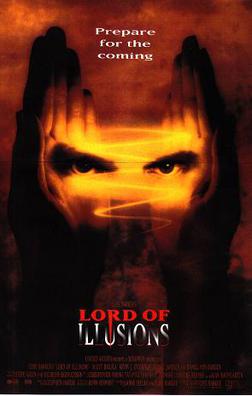
Lord of Illusions is a 1995 American neo-noir supernatural horror film written and directed by Clive Barker, based on his own short story The Last Illusion published in 1985 in the anthology Books of Blood Volume 6. The same story introduced Barker's occult detective Harry D'Amour, who later appeared in several prose stories and comic books. Lord of Illusions is D'Amour's first onscreen appearance, with the character portrayed by actor Scott Bakula. Other actors appearing in the film include Kevin J. O'Connor, Famke Janssen and Daniel von Bargen. The story features D'Amour, who has had several experiences with the supernatural, embarking on an investigation involving a stage illusionist named Swann and a cult led by a sorcerer named Nix.

Pinhead is a fictional character and the main antagonist of the Hellraiser franchise. The character first appeared as an unnamed figure in the 1986 Clive Barker novella The Hellbound Heart. When Clive Barker adapted the novella into the 1987 film Hellraiser, he referred to the character in early drafts as "the Priest" but the final film gave no name. The production and make-up crew nicknamed the character "Pinhead"—derived from his bald head studded with nails—and fans accepted the sobriquet. The name was then used in press materials, tie-in media, and on-screen in some of the film's sequels, although Barker himself despises the moniker.
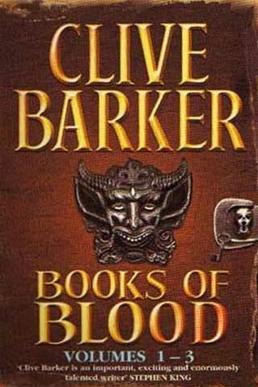
Books of Blood is a series of six horror fiction anthologies collecting original stories written by British author, playwright, and filmmaker Clive Barker in 1984 and 1985. Known primarily for writing stage plays beforehand, Barker gained a wider audience and fanbase through this anthology series, leading to a successful career as a novelist. Originally presented as six volumes, the anthologies were subsequently re-published in two omnibus editions containing three volumes each. Each volume contains four, five or six stories. The Volume 1–3 omnibus contained a foreword by Barker's fellow Liverpudlian horror writer Ramsey Campbell. Author Stephen King praised Books of Blood, leading to a quote from him appearing on the first US edition of the book: "I have seen the future of horror and his name is Clive Barker."

Hellbound: Hellraiser II is a 1988 supernatural horror film directed by Tony Randel and starring Clare Higgins, Ashley Laurence, Kenneth Cranham and Doug Bradley. The second film in the Hellraiser franchise, Hellraiser II draws heavily upon its precursor, Hellraiser, which was released a year before. Laurence reprises her role as Kirsty Cotton, who is admitted into a psychiatric hospital after the events of the first film. There, the head doctor (Cranham) unleashes the Cenobites, a group of sadomasochistic beings from another dimension.

Hellraiser III: Hell on Earth is a 1992 American supernatural horror film and the third installment in the Hellraiser film series. It was directed by Anthony Hickox and stars Terry Farrell, Paula Marshall, Kevin Bernhardt, and Doug Bradley. Ashley Laurence, who starred in the previous two films, reprises her role as Kirsty Cotton in a cameo appearance.
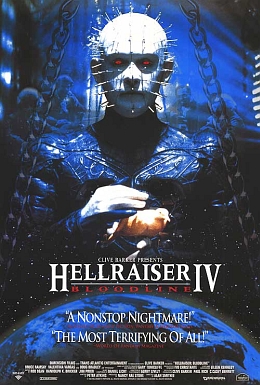
Hellraiser: Bloodline is a 1996 American science fiction horror film and the fourth installment in the Hellraiser series, which serves as both a prequel and a sequel. Directed by Kevin Yagher and Joe Chappelle, the film stars Doug Bradley as Pinhead, reprising his role and now the only remaining original character and cast member. It also features Bruce Ramsay, Valentina Vargas, Kim Myers and Adam Scott in his first major film role. It was the last Hellraiser film to be released theatrically and the last to have any major official involvement with series creator Clive Barker until the 2022 reboot.

Hellraiser: Inferno is a 2000 American horror film. It is the fifth installment in the Hellraiser series, and the first Hellraiser film to be released direct-to-video. It was directed by Scott Derrickson, in his feature-length directorial debut, and stars Craig Sheffer, Nicholas Turturro, James Remar, and Doug Bradley. The film follows Joseph Thorne, a corrupt detective who discovers the Lemarchand's box at a crime scene, which results in his life gradually unraveling.
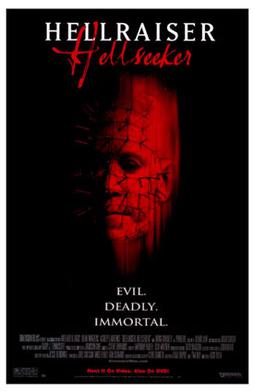
Hellraiser: Hellseeker is a 2002 supernatural horror film directed by Rick Bota and written by Carl V. Dupré and Tim Day. The sixth film in the Hellraiser series, it features the return of Kirsty Cotton, the heroine from Hellraiser and its sequel. The film stars Dean Winters, Ashley Laurence, and Doug Bradley.

Hellraiser: Deader is a 2005 American supernatural horror film and the seventh installment in the Hellraiser series. Directed by Rick Bota, the original script was written by Neal Marshall Stevens. As with Hellraiser: Hellseeker it began as an unrelated spec script, which was subsequently rewritten as a Hellraiser film. Like Inferno, series creator Clive Barker did not have an involvement in the production. The film stars Kari Wuhrer, Paul Rhys, Simon Kunz, and Doug Bradley.
Hellraiser is a British-American horror media franchise that consists of eleven films, as well as various comic books, and additional merchandise and media. Based on the novella The Hellbound Heart by English author Clive Barker, the franchise centers around the Cenobites which includes the primary antagonist named Pinhead.

The Scarlet Gospels is a 2015 horror novel by author Clive Barker which acts as a continuation to both his previous novella The Hellbound Heart and his canon of Harry D'Amour stories. The book concerns the Hell Priest, the demonic Cenobite nicknamed "Pinhead", and his efforts to gain power. Occult detective Harry D'Amour must journey into Hell to rescue his friend and stop the Hell Priest's plans. The book was the first in which the Hell Priest was officially given a name by Clive Barker, who disliked the nickname 'Pinhead' given his character by others.
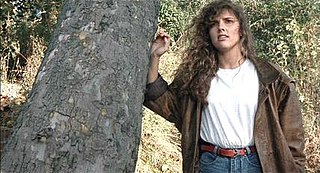
Kirsty is a fictional character from the Hellraiser media franchise. Created by writer Clive Barker, Kirsty first appears in the 1986 novella The Hellbound Heart. Her full name is identified in the sequels as Kirsty Singer, before being adapted in the 1987 film adaptation Hellraiser as Kirsty Cotton. The character served as a major focus in the original film and its sequel Hellbound: Hellraiser II, later playing a supporting role in Hellraiser VI: Hellseeker. In all of her appearances in the film series, she was portrayed by actress Ashley Laurence. The film describes her as being Larry Cotton's daughter, while in the novel she is simply a friend of his.

Hellraiser: Judgment is a 2018 American horror film written and directed by Gary J. Tunnicliffe, based on the characters created by Clive Barker. The tenth installment in the Hellraiser film series, the film stars Damon Carney, Randy Wayne, Alexandra Harris, Heather Langenkamp, and Paul T. Taylor, and centers on three police detectives who, investigating a series of murders, are confronted by the denizens of hell. The film expands the fictional universe by introducing a new faction of hell: the Stygian Inquisition. While the Cenobites offer sadomasochistic pleasures to humans that enter their dominion, the Inquisition processes the souls of sinners. Tunnicliffe plays the Inquisition's auditor, a prominent role in the film.
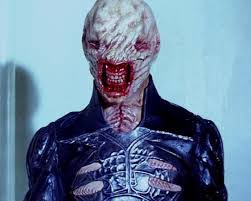
Chatterer is a fictional character appearing in the Hellraiser film series. He is a Cenobite, an order of extradimensional sadomasochists who experiment in extreme forms of hedonism. His name comes from the constant clicking of his teeth, his only means of communication. He serves the Cenobites' leader Pinhead. Chatterer has become a fan favourite character in the Hellraiser franchise.

Hellraiser is a 2022 supernatural horror film directed by David Bruckner, with a screenplay by Ben Collins and Luke Piotrowski, from a screen story co-written with David S. Goyer. A reboot of the Hellraiser franchise, the eleventh installment overall, and the second adaptation of the 1986 novella The Hellbound Heart by Clive Barker following the 1987 film, the film stars Odessa A'zion as a young woman recovering from addiction who ends up with a mechanical puzzle box that can summon the Cenobites, humanoid beings who thrive on pain being pleasure. Jamie Clayton, Adam Faison, Drew Starkey, Brandon Flynn, Aoife Hinds, Jason Liles, Yinka Olorunnife, Selina Lo, Zachary Hing, Kit Clarke, Goran Višnjić, and Hiam Abbass appear in supporting roles.

















